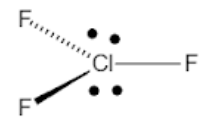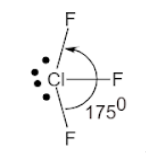
The shape of $CI{{F}_{3}}$ molecule is:
A.Triangular planer
B.Pyramidal
C.T-shape
D.Trigonal bipyramidal
Answer
555.6k+ views
Hint: Using the VSEPR theory, the electron bond pairs and lone pairs on the centre atom help predict the shape of a molecule which is determined by the location of the nuclei and its electrons.
Complete answer:
- Molecular geometry, also known as the molecular structure, is the three-dimensional structure or arrangement of atoms in a molecule.
- To determine the shapes of molecules, we must become familiar with the Lewis electron dot structure. It helps us identify the bond pairs and the lone pairs.
- Then, with the Lewis structure, we apply the valence-shell electron-pair repulsion (VSEPR) theory to determine the molecular geometry and the electron-group geometry.
- According to the VSEPR bond theory, Chlorine trifluoride has 10 electrons around the central chlorine atom.
- This means that there are 5 electron pairs arranged in a trigonal bipyramidal shape with a ${{175}^{0}}$ bond angle.
- But, due to the presence of two equatorial lone pairs, the final structure is T−shaped.

Trigonal bipyramidal

T-shape
Therefore, the answer to the question is (C) T-shape.
Note:
When Cl needs to combine with Fluorine atoms to form ClF3 it needs three unpaired electrons to bond with three F-atoms. Here, one of the paired electrons of Cl in the 3p subshell remains as a lone pair or unpaired. During hybridization, one 3s, three 3p and one of the 3d orbitals participate in the process which leads to the formation of five $s{{p}^{3}}d$ hybrid orbitals.
Complete answer:
- Molecular geometry, also known as the molecular structure, is the three-dimensional structure or arrangement of atoms in a molecule.
- To determine the shapes of molecules, we must become familiar with the Lewis electron dot structure. It helps us identify the bond pairs and the lone pairs.
- Then, with the Lewis structure, we apply the valence-shell electron-pair repulsion (VSEPR) theory to determine the molecular geometry and the electron-group geometry.
- According to the VSEPR bond theory, Chlorine trifluoride has 10 electrons around the central chlorine atom.
- This means that there are 5 electron pairs arranged in a trigonal bipyramidal shape with a ${{175}^{0}}$ bond angle.
- But, due to the presence of two equatorial lone pairs, the final structure is T−shaped.

Trigonal bipyramidal

T-shape
Therefore, the answer to the question is (C) T-shape.
Note:
When Cl needs to combine with Fluorine atoms to form ClF3 it needs three unpaired electrons to bond with three F-atoms. Here, one of the paired electrons of Cl in the 3p subshell remains as a lone pair or unpaired. During hybridization, one 3s, three 3p and one of the 3d orbitals participate in the process which leads to the formation of five $s{{p}^{3}}d$ hybrid orbitals.
Recently Updated Pages
Why are manures considered better than fertilizers class 11 biology CBSE

Find the coordinates of the midpoint of the line segment class 11 maths CBSE

Distinguish between static friction limiting friction class 11 physics CBSE

The Chairman of the constituent Assembly was A Jawaharlal class 11 social science CBSE

The first National Commission on Labour NCL submitted class 11 social science CBSE

Number of all subshell of n + l 7 is A 4 B 5 C 6 D class 11 chemistry CBSE

Trending doubts
What is meant by exothermic and endothermic reactions class 11 chemistry CBSE

10 examples of friction in our daily life

One Metric ton is equal to kg A 10000 B 1000 C 100 class 11 physics CBSE

1 Quintal is equal to a 110 kg b 10 kg c 100kg d 1000 class 11 physics CBSE

Difference Between Prokaryotic Cells and Eukaryotic Cells

What are Quantum numbers Explain the quantum number class 11 chemistry CBSE




